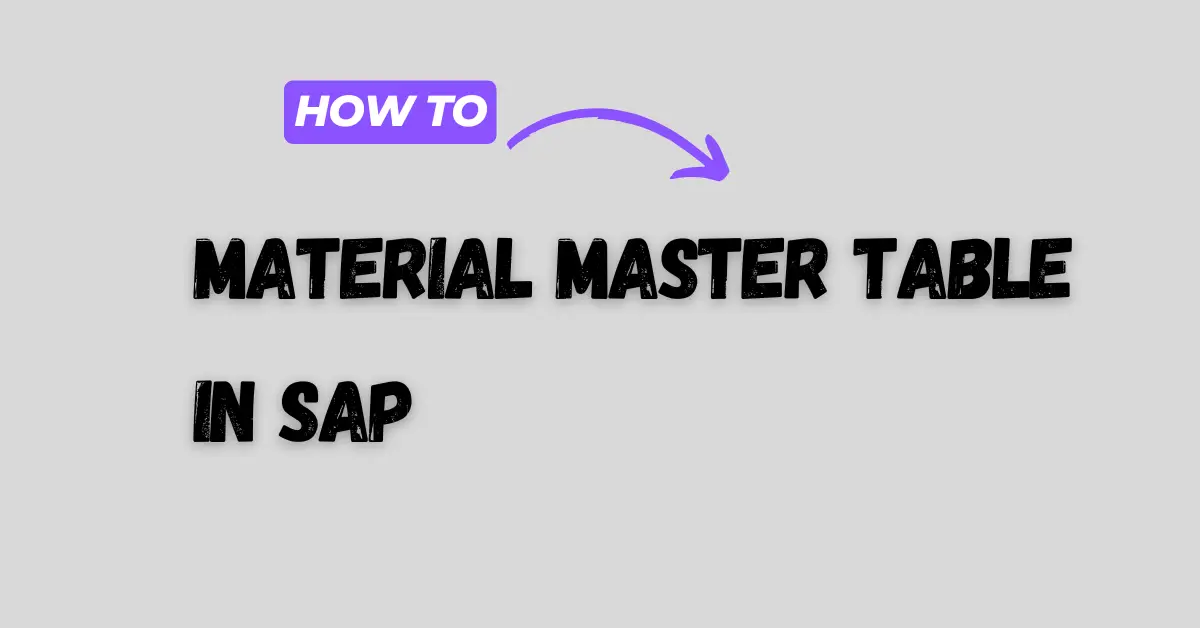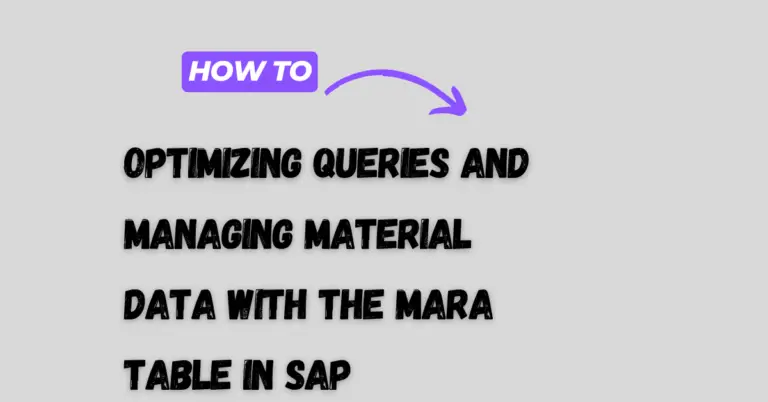Material Master table in SAP using SQL
For anyone new to SAP, especially those working on the backend side to fetch data using SQL queries, one of the key areas you’ll need to understand is the Material Master. It is a central repository for all material-related information within SAP and plays a crucial role across various modules such as purchasing, inventory management, sales, and accounting.
In this post, we’ll take a deep dive into the most important Material Master tables, explore their relationships, and provide guidance on how to query them effectively using SQL. By the end, you’ll be equipped with the knowledge to retrieve valuable material data across different organizational levels.

What is the Material Master table in SAP?
The Material Master is the core source of information for all materials used in a company. It contains data that is shared by multiple modules, including Logistics, Sales and Distribution, Purchasing, Inventory Management, and more. By centralizing the data, SAP ensures consistency and eliminates redundancies.
Each material in SAP has a unique material number (MATNR), which serves as a key identifier across all relevant tables. SAP breaks down material information into various “views,” each tailored to a specific business function such as sales, purchasing, or accounting
Comprehensive Guide to Production Order Table in SAP
The Key Material Master Tables in SAP
1. MARA (General Material Data)
The MARA table stores the basic information about each material. It holds key fields such as:
- MATNR (Material Number): The unique identifier for each material.
- MTART (Material Type): This defines the classification of the material, such as raw material, finished product, etc.
- MBRSH (Industry Sector): Specifies the industry sector the material belongs to (e.g., chemicals, electronics).
The MARA table is your starting point when querying material data. By linking the MATNR field, you can connect MARA to other tables for more specific data.
Example SQL Query: Retrieving basic material information.
SELECT MATNR, MTART, MBRSH
FROM MARA
WHERE MTART = 'FERT';
This query will return all materials classified as finished products (FERT).
2. MARC (Plant Data for Material)
The MARC table contains plant-specific information for each material. This data is critical for manufacturing, production planning, and inventory management at the plant level.
- MATNR: Material Number (links to MARA).
- WERKS: Plant ID, specifying the plant where the material is managed.
- DISMM: MRP Type, which controls the material requirement planning for the material in that plant.
If your company operates across multiple plants, the MARC table is essential for distinguishing material availability and processing at each location.
Example SQL Query: Fetching plant-specific details.
SELECT MATNR, WERKS, DISMM
FROM MARC
WHERE WERKS = '1000';
This query retrieves material data for plant 1000.
3. MARD (Storage Location Data for Material)
The MARD table holds inventory information for each material at the storage location level. Fields include:
- MATNR: Material Number.
- WERKS: Plant.
- LGORT: Storage Location.
- LABST: Stock Quantity (available stock at the storage location).
For businesses managing stock across multiple storage locations, MARD helps track material quantities in each location.

Example SQL Query: Retrieving stock levels by storage location.
SELECT MATNR, LGORT, LABST
FROM MARD
WHERE WERKS = '1000' AND LGORT = '0001';
This query fetches stock levels for storage location 0001 in plant 1000.
4. MBEW (Material Valuation)
MBEW stores accounting-related data, particularly the valuation of materials. Key fields include:
- MATNR: Material Number.
- BWKEY: Valuation Area, often linked to a plant or company code.
- BWTAR: Valuation Type, which allows materials to be evaluated separately, e.g., based on origin or batch.
This table is essential for understanding the financial impact of material movements and stock valuations within your organization
Example SQL Query: Fetching valuation data.
SELECT MATNR, BWKEY, BWTAR
FROM MBEW
WHERE BWKEY = '1000';
This query retrieves valuation data for materials in plant 1000.
5. MVKE (Sales Data for Material)
MVKE stores sales-specific data for materials, such as:
- MATNR: Material Number.
- VKORG: Sales Organization.
- VTWEG: Distribution Channel.
This table is important for companies involved in sales and distribution, as it helps manage material availability for different sales channels and regions.
Example SQL Query: Retrieving sales organization data.
SELECT MATNR, VKORG, VTWEG
FROM MVKE
WHERE VKORG = '2000';
This query fetches sales data for materials handled by sales organization 2000.
Material Master Data Relationships and SQL Querying Best Practices
Understanding the relationships between these tables is critical for constructing efficient SQL queries. Generally, MATNR is the key field linking different Material Master tables. Depending on your query needs, you might need to join multiple tables like MARA with MARC or MARD to retrieve comprehensive material data.
Here are some best practices to keep in mind:
- Use Proper Joins: When querying across multiple tables, always use INNER JOIN or LEFT JOIN to fetch related records based on the MATNR field.
SELECT MARA.MATNR, MARA.MTART, MARC.WERKS, MARD.LABST
FROM MARA
INNER JOIN MARC ON MARA.MATNR = MARC.MATNR
INNER JOIN MARD ON MARC.MATNR = MARD.MATNR
WHERE MARC.WERKS = '1000';
- Indexing: For large datasets, ensure that commonly queried fields like MATNR and WERKS are indexed for optimal performance.
- Filter by Organizational Levels: SAP structures Material Master data by organizational levels (such as plants, storage locations). When querying data, always filter by relevant levels to avoid performance issues and return meaningful results.
- Check for Data Consistency: Material data can change over time. Use change log tables like CDHDR and CDPOS to track changes to material records.
Frequently Asked Questions (FAQs)
What is the most common field used to join Material Master tables?
The MATNR (Material Number) field is the most common field used to join Material Master tables. It uniquely identifies each material and allows you to connect related tables like MARA, MARC, MARD, MBEW, and MVKE.
Can I track changes to Material Master data?
Yes, you can track changes to Material Master data using the change log tables CDHDR (Change Document Header) and CDPOS (Change Document Items). These tables capture changes to material records, such as updates to material descriptions or stock quantities.
How do I retrieve sales data for materials in a specific plant?
To retrieve sales data for a material in a specific plant, you would join the MARC table (plant data) with the MVKE table (sales data) using the MATNR field.
Conclusion
The Material Master is a cornerstone of SAP, especially for organizations dealing with logistics, sales, and inventory management. Understanding how to query the Material Master tables like MARA, MARC, MARD, MBEW, and MVKE will provide invaluable insights into material availability, stock levels, and valuation across organizational levels.
By mastering SQL queries for these tables, you can unlock the full potential of your SAP system and support critical business decisions with accurate, real-time material data.
Learn about Vendor Master Table in SAP


